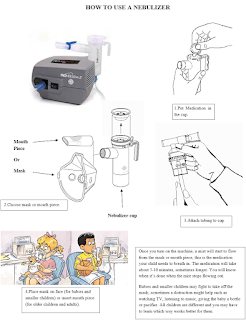Asthma, the most common childhood chronic disease is a long-term lung disease that affects the airways and can cause wheezing, coughing and chest tightness.
For most kids with asthma, their symptoms can be controlled, sometimes so good that flare-ups are rare but learning about asthma can be the most difficult part of asthma care
Don’t be discouraged! Once you and your family have become familiar with dealing with asthma, it will become a normal part of your routine. These little tips can be of most help to you
• Have a plan and stick to it: Your child should have an asthma action plan written by the doctor. By following this plan, you will learn how to care for your child and when to call the doctor for help ( You can check our previous post to know when to see a doctor)
• Take medicines as prescribed
• Identify and avoid triggers
• Make sure your child take a yearly flu vaccine: The flu vaccine is recommended for all kids, particularly those with asthma. If kids with asthma have the flu, they’re at risk for flare-ups and developing a more serious illness
• Use tools when required: One way to help predict if a flare-up is on its way is to use asthma tools, like an asthma diary and peak flow meter. The diary helps you to keep track of your child’s symptoms, need for medicines, and more. A peak flow meter is a handheld tool that measure out how well your child can blow air out of the lungs. It can tell if airways are getting constrict and blocked, and whether your child is at risk for a flare-up
• Know the signs of a flare-up
• Help your child to stay active physically
• Focus on your child's weight
• See your child’s doctor regularly
Treatment/Management
If your child has asthma, you have to work with your health care provider to create a treatment plan which include ways to manage your child’s symptoms and prevent asthma attacks such as
• Strategies to avoid triggers
• Short-term relief medicines: They help prevent symptoms or relieve symptoms during an attack. They include an inhaler to have for your child at all times and other types of medicines which work quickly to open the airways eg Salbutamol
• Control medicines: They work by reducing airway inflammation and preventing narrowing of the airways but not all children will take control medicines eg inhaled corticosteroids, leukotriene modifiers, etc
• If your child has a severe attack and the short-term relief medicines do not work, get medical help immediately
Prevention
Careful planning and averting asthma triggers are the best ways to prevent asthma attacks. Others may include
• Limiting exposure to asthma triggers
• Don’t allow smoking around your child
• Encourage your child to be active
• Help your child to maintain a healthy weight at all times
• Keep heartburn under control
• Keep your child well hydrated
• See the doctor when necessary
Special Information…
How to use an Inhaler with a spacer/ without one
Step 1: Wash your hands
2: Shake the inhaler well. Then attach it to the spacer if there is one
3: Breathe out completely to empty the lungs
4: Close the lips and teeth around the spacer mouthpiece
5: Press down on the inhaler. This will put one puff of the medicine in the inhaler
6: Breathe in slowly until the lungs are full
7: Hold a deep breath for 10secs to allow the medicine to work deep in the lungs
8: If your doctor has ordered 2 or more puffs, wait 1minute. Then repeat steps 1-7
9: Rinse your mouth
How to use a home nebulizer
Step 1: Wash your hands
2: Put the drug in the nebulizer
3: The tubes should be connected from the compressor to the base
4: Attach the mouthpiece or mask
5: Turn the compressor on and look out for a light mist to come from the nebulizer
6: Put the mask on your child’s face or put the mouthpiece in their mouth and have them close their lips around it
7: Have the child breathe in and out until the treatment time is up
8: Turn the nebulizer off when the drug is gone
9: Have your child cough to clear out any mucus
10: Have them rinse their mouth
Dr. Favvy
Has this post been helpful to you?
Kindly drop your comments, questions and suggestions on our Facebook page 👇
https://www.facebook.com/dr.favvy
Join the fastest growing online community today!
Click the link Now to get started 👇
https://www.facebook.com/dr.favvy
Disclaimer
All information on mypaediatricdoctor is for educational purposes only. For specific medical advise, diagnosis and treatment, kindly consult your doctor or pharmacist!



Comments
Post a Comment